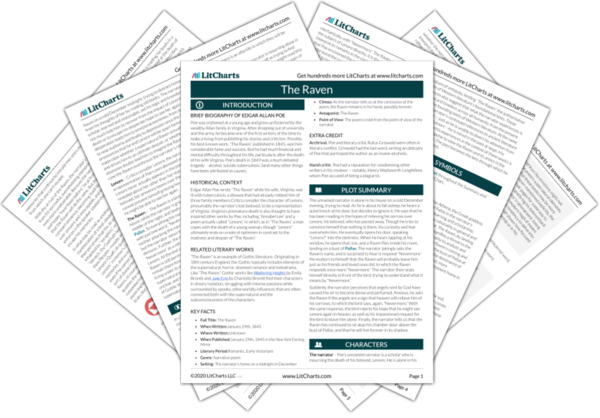In an essay titled “The Philosophy of Composition,” in which Poe explained his writing of “The Raven,” he describes the narrator as a scholar, a learned person devoted to rational investigation. It is therefore natural for the speaker to attempt to escape his obsessive memories of his wife by reading “ancient lore,” and when he senses Lenore’s presence he comforts himself with the words “Nothing more” to assure himself that a ghost has not actually paid him a visit. Even after he meets the Raven, he supposes that its first replies of “Nevermore” are only “stock and store,” that the bird is only parroting a phrase it has heard before from a previous unhappy owner.
Put another way, the speaker attempts to respond to and understand the Raven (and the world) in a rational manner. But the poem shows how the speaker’s rationality can’t cope with the profound irrationality of the Raven and its responses, and even shows how the speaker’s despair at the death of Lenore, and his desperate attempts to understand the Raven rationally, leads him to a frantic irrationality of his own. Although the Raven exerts no tangible power over the speaker, and in fact seems not even to notice the narrator’s pained reactions to its constant message, the narrator nevertheless sees the bird as an ill omen of tragedy that means him harm. The speaker’s obsession with his beloved’s death is such that he immediately associates the bird’s arrival with his memories of Lenore, in his despair making this connection without concrete evidence.
Further, it’s important to note that the Raven is gifted with speech, not conversation: no matter what the speaker says, whether to himself or directly to the bird, the Raven responds, mechanically, with “Nevermore.” The Raven never addresses the subject of Lenore directly; it is the narrator who chooses to interpret its remarks in the context of his lost love. Considering that Poe envisioned the narrator as a scholar, it is possible to understand the narrator’s reading of the Raven’s remarks as similar to how he might approach his books in that he performs a sort of literary analysis of the Raven and its comments, viewing them as the denial of all his desires and hopes. The narrator, whose despair over death leads him to need to understand whether he might ever again hope to see Lenore, interprets that the Raven is responding to him and is bringing him a message, but it is not at all clear that is the case. He attempts, over and over, to rationally make sense of a response that makes no sense – and, as the cliché goes, continuing to do the same thing with the hope of a different result is the definition of insanity.
Through the poem, the Raven perches above a bust, or statue, of Pallas — a reference to Pallas Athena, the Greek goddess of wisdom. This placement of the “nevermore”-spouting bird on top of the goddess of wisdom, suggests the victory of the irrational over the narrator’s ability to think clearly and rationally. At the conclusion of the poem, the narrator describes seeing the Raven still sitting upon the bust of Pallas, “never flitting.” The image places irrationality above rationality, forever. One can therefore read “the Raven” as suggesting that the bird makes its eternal nest solely in the narrator’s frantic mind. His irrational tendencies in the face of his lost Lenore, bordering on madness, make his rational approach moot, suggesting that the aftermath of an event as traumatizing as the death of one’s beloved cannot be overcome with measured, sensible thinking.
Rationality and Irrationality ThemeTracker

Rationality and Irrationality Quotes in The Raven
Over many a quaint and curious volume of forgotten lore…
And the only word there spoken was the whispered word, “Lenore?”
This I whispered, and an echo murmured back the word, “Lenore!”
Tell me what thy lordly name is on the Night’s Plutonian shore!
“Doubtless,” said I, “what it utters is its only stock and store”…
Then, upon the velvet sinking, I betook myself to linking
Fancy unto fancy…
Then, methought, the air grew denser, perfumed from an unseen censer
Swung by Seraphim whose foot-falls tinkled on the tufted floor…
“Quaff, oh quaff this kind nepenthe and forget this lost Lenore!”
And the Raven, never flitting, still is sitting, still is sitting
On the pallid bust of Pallas just above my chamber door…
















